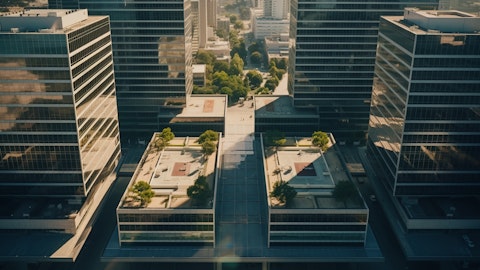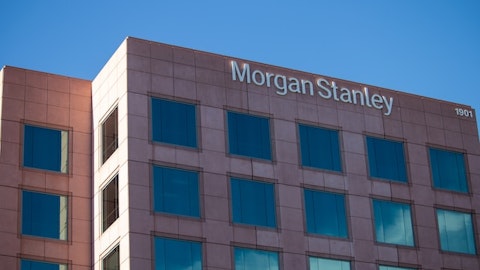Michael Goldsmith: Good afternoon, and thanks a lot for taking my question. David, base minimum rents are up healthily in a low single-digit range year-over-year, while your tenant sales per square foot are down slightly. So, can you just talk a little bit about these dynamics. Is that a function of your range, kind of catching up to some of the street, the tenants have experienced before their sales have started to come down and just how long are these dynamics kind of sustainable like this? Thank you.
David Simon: Sure . Good question, so I will say this. I think the rent – the going-in rents and renewals for new leases are very much sustainable. If you look at our occupancy costs, we are still at the low end of our historical range, and we’re at 12.6% and we have run up to 14% plus before. And I would also, I would also caution report, these are the sales that our tenants are reporting to us, but they are somewhat affected by returns they it and so on. We actually think our sales per foot are higher than this. Some cases they have the ability to offset our returns in most cases, they don’t. So, I just put that out there, so I wouldn’t – and I mentioned this maybe two, three years ago, probably certainly pre-pandemic, but we report it.
I know the market likes it. We actually think our sales were higher that come from our properties and then they are somewhat affected by returns. And we think some of – a lot of those returns are Internet sales returns. So, they don’t even come from our properties. And so again, when we look at it, we feel like supply and demand, low occupancy cost, high retail sales, and just overall demand will be able to generate kind of the new leasing renewal spreads that we’ve seen over the last couple of years.
Michael Goldsmith: Thank you very much.
Operator: Thank you. Our next question is from Floris van Dijkum with Compass Point. Please proceed with your question. Floris, is your line on mute?
David Simon: Floris. Looks like we lost for Floris.
Operator: Our next question is from Craig Mailman with Citigroup. Please proceed with your question.
Craig Mailman: Hi guys. Just – sorry. Just going back to maybe the reinvestments in here. You guys have plenty of cash after the dividend. And then just trying to curious at this point. What is the level of anchor box reinvestment you guys think you need to do just given what may be vacant today. And after you guys were spared kind of some of the recent Macy’s closings. But just as you look at the portfolio today, kind of what do you think over the next two, three years, you guys could ultimately get back and have to re-tenant and just talked a lot about how the leasing environment is could. Just, what’s the outlook for re-tenanting those boxes today? What’s the targeted kind of make-up there and is luxury still doing enough to be able to be the primary kind of backfill option?
David Simon: Well, on the – Craig, on the department store boxes, I don’t have it off the top of my head, but the launch we own basically don’t have a ton of work to do. We have a handful of boxes that we own that are in process, like for instance, I’ve mentioned Brea, but just briefly on the call, we did – that was a former Sears store we tore it down in development now under construction now. So the actual stores that we own are not many, probably under 10 at this point that are either currently under construction or in process. So, very small amounts of, kind of a less of an opportunity than you think. The ones that we felt Transformco still owns some boxes and so does Seritage. So you know well, in our properties. So, we’ll see how that evolves.
I mean, eventually some of those could be opportunities for us to buy and redevelop. We haven’t made deals on those just because bid and the ask has been too great, but we – and I don’t think luxury is really going to be the dominant theme on a lot of these mixed use – I’m sorry, on these boxes. I think a lot of it will be – continue to be a mixed-use development that we’re doing. And obviously, opening up, if it’s in a closed mall opening the center up with restaurants and entertainment and so on and it has worked very well. So, we have a number under construction or about to be under construction, but we don’t really have that existing pipe that until we make more deals to buy some of the boxes back. It’s not as big as you might think that it’s only a handful.
Now Macy’s is right there, they announced some store closings none of which are ours. So, we’re always very focused on knowing exactly where we might be at risk. And I would point out, very importantly when Sears went out of business, the whole market said, how are you going to survive, Sears going out of business. They had 800 department stores at that time, frankly they’re down, I believe they were operating five, six, seven, eight. I think we actually have the most between us and the Taubman portfolio, but how are you going to survive, the fact of the matter is, it was a non-event to the mall customer, and If anything is we’ve gotten those boxes back. We’ve made the center better. So, as we look, we don’t look at box – the changes in box as a concern, we view it really more aggressively and progressively.
And that’s something that will enhance the properties in the portfolio and the assets that we were worried about that couldn’t survive that, basically don’t exist in our portfolio anymore. So if you asked me that question 10 years ago, I might have a different answer.
Craig Mailman: Great, thank you.
David Simon: Craig, I hope you get better prior to the Citi Conference, I’m sure you well, but you sound like you’ve lost your voice.
Craig Mailman: Yes. Hoping to be on the mend by then. Thanks, David.
David Simon: You will.
Operator: Our next question is from Vince Tibone with Green Street. Please proceed with your question.
Vince Tibone: Hi, good evening . Could you help me better understand, how much incremental FFO, we should expect in ’24 from development and redevelopment projects that stabilized either later in ’23 or slated to be finished in ’24, just any color to help us better understand the timing of incremental NOI and FFO from all the development activities would be helpful?
David Simon: Yes, in fact, it’s interesting you actually take us – I think in ’24 we’re taking a step back. I’ll just give you a trivial example. And I mentioned, Brian now for the third time, but we have a whole wing that’s connected to the former Sears department store that we’re redeveloping. We’ll have some outdoor shops, we’re building Dick’s Sporting Goods. We have a Lifetime Fitness resorts and then we’ll do roughly 350 apartments or so, but that wing leading to Sears, we’ve had to de-lease it to ultimately put in, I am not sure, I am allowed to say it, but I’ll say it anyway, Zara, Uniqlo and they won’t open until end of ’24, best-case. So. this advanced, by and large, all of this stuff in the U.K. that we’ve listed and I don’t believe Brea’s in the year if it is, just it will be there shortly.
None that is really – affect that really gets in ’24, we do have Tulsa opening in late-summer that will have a marginal impact leasing is going well. With all the redeveloping, this is really more of a ’25 – ’26 story. And the one that will see the benefit of this year and I have a number handy is 6, which we opened in ’23. That’s kind of the one that would say most meaningful of it. But most of the redevelopment is of ’25 – ’26 story.
Vince Tibone: No, that’s really helpful. I mean, is there any like for just in terms of the get the $1.3 billion that’s active today, plus $800 million you’re going to start. I mean what’s the fair assumption for ’25 – ’26, in terms of level of maybe spend stabilizing, I mean I have to look at how we model it, like, is $500 million stabilizing annually at, we’ll call it, 7% – 8% yield a fair assumption, or that’s something I’m trying to get at like how quickly.
David Simon: No. I appreciate that. If you don’t include what I saw ground up, new development, I would say probably about between $600 million and $800 million a year and our goal would hopefully be to bring that in at north of eight. Obviously, if It is multifamily, you can still create value at a lower yield than that, and in some cases, we’re building at a lower yield than that, like for instance both Brea’s apartments and the ones that we’re building at the former Northgate Mall, where we’re basically about to start construction there, will be sub-eight. So, it may being round down that 8%, but if you’re targeting kind of everything else, we would hope to be north of that.
Vince Tibone: Thank you. That’s all really helpful color. I appreciate it.
David Simon: Thank you.
Operator: Our next question is from Ron Kamdem with Morgan Stanley. Please proceed with your question.
Ron Kamdem: Great. Just a two-parter really quickly. Starting with the core NOI, just in ’24, can you just touch on the tourist centers and how much recovery there is and how much upside for volume to ’24 , as well as the variable to fixed conversion, just trying to get a sense of how much of a tailwind that is to the core. And then on the sort of other platform investments, maybe could you just touch on what seasonality should we be thinking about between sort of the first part of the year and 4Q . Thanks so much.





